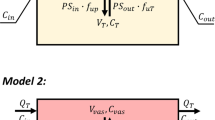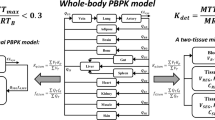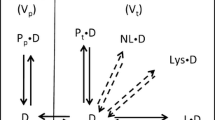Abstract
An important parameter used in physiologically based pharmacokinetic models is the partition coefficient (Kp), which is defined as the ratio of tissue drug concentration to the concentration of drug in the emergent venous blood of the tissue. Since Kp is governed by reversible binding to protein and other constituents in blood and tissue, an attempt was made here to estimate the Kp values for a model drug ethoxybenzamide (EB) by means of in vitrobinding studies and to compare these Kp values to those obtained from in vivokinetic parameters observed following the administration of EB by two different routes, i.e., i.v. bolus injection and constant rate infusion. The Kp values obtained by using these three different methods were in reasonably good agreement suggesting that binding data obtained in vitrocan successfully be used to estimate in vivodistribution.
Similar content being viewed by others
References
R. L. Dedrick and B. K. Bischoff. Pharmacokinetics in application of the artificial kidney.Chem. Eng. Progr. Symp. Ser. 64(84):32–44 (1968).
K. B. Bischoff and R. L. Dedrick. Thiopental pharmacokinetics.J. Pharm. Sci. 57:1346–1351 (1968).
K. B. Bischoff, R. L. Dedrick, and D. S. Zaharko. Preliminary model for methotrexate pharmacokinetics.J. Pharm. Sci. 59:149–154 (1970).
K. B. Bischoff, R. L. Dedrick, D. S. Zaharko, and J. A. Longstreth. Methotrexate pharmacokinetics.J. Pharm. Sci. 60:1128–1133 (1971).
N. Benowitz, R. P. Forsyth, K. L. Melmon, and M. Rowland. Lidocaine disposition kinetics in monkey and man. I. Prediction by a perfusion model.Clin. Pharmacol. Ther. 16:87–98 (1974).
L. I. Harrison and M. Gibaldi. Physiologically based pharmacokinetic model for digoxin distribution and elimination in the rat.J. Pharm. Sci. 66:1138–1142 (1977).
P. A. Harris and J. F. Gross. Preliminary pharmacokinetics model for adriamycin (NSC-123127).Cancer Chemother. Rep. 59:819–825 (1975).
H. S. G. Chen and J. F. Gross. Estimation of tissue-to-plasma partition coefficients used in physiological pharmacokinetic models.J. Pharmacokin. Biopharm. 7:117–125 (1979).
J. H. Lin, M. Hayashi, S. Awazu, and M. Hanano. Correlation betweenin vitro andin vivo drug metabolism rate: oxidation of ethoxybenzamide in rat.J. Pharmacokin. Biopharm. 6:327–337 (1978).
K. S. Pang and M. Rowland. Hepatic clearance of drugs I. Theoretical considerations of a “well-stirred” model and a “parallel tube” model. Influence of hepatic blood flow, plasma and blood cell binding, and the hepatocellular enzymatic activity on hepatic drug clearance.J. Pharmacokin. Biopharm. 5:625–653 (1977).
J. H. Lin, Y. Sugiyama, S. Awazu, and M. Hanano. Physiological pharmacokinetics of ethoxybenzamide based on biochemical data obtainedin vitro as well as on physiological data.J. Pharmacokin. Biopharm. 10:649–661 (1982).
D. Shen and M. Gibaldi. Critical evaluation of use of effective protein fractions in developing pharmacokinetic models for drug distribution.J. Pharm. Sci,63:1698–1703 (1974).
L. S. Schanker and A. S. Morrison. Physiological disposition of guanethidine in rat and its uptake by heart slices.Int. J. Neuropharmacol. 4:27–39 (1965).
R. Kuntzman, M. Jacobson, I. Tsai, and J. J. Burns. Certain aspects of drug binding to nonplasma protein as illustrated by studies with cyclicine, chlorcyclizine, and polymyxin B.Ann. N.Y. Acad. Sci. 226:131–147 (1973).
D. V. Prag and E. J. Simon. Studies on the intracellular distribution and tissue binding of dihydromorphine-7,8-H3 in rat.Proc. Soc. Exp. Biol. Med. 122:6–11 (1966).
B. Fichtl, N. Filous, and H. Kurz. Binding of drug to muscle tissue.Naunyn- Schmiedberg's Arch. Pharmacol. 293 (suppl R):46 (1976).
B. E. Ballard. Pharmacokinetics and temperature.J. Pharm. Sci. 63:1345–1358 (1974).
Y. Igari, Y. Sugiyama, S. Awazu, and M. Hanano. Interspecies difference in drug protein binding-temperature and protein concentration dependency: effect on calculation of effective protein binding.J. Pharm. Sci. 70:1049–1053 (1981).
Author information
Authors and Affiliations
Rights and permissions
About this article
Cite this article
Lin, J.H., Sugiyama, Y., Awazu, S. et al. In vitro andin vivo evaluation of the tissue-to-blood partition coefficient for physiological pharmacokinetic models. Journal of Pharmacokinetics and Biopharmaceutics 10, 637–647 (1982). https://doi.org/10.1007/BF01062545
Received:
Revised:
Published:
Issue Date:
DOI: https://doi.org/10.1007/BF01062545




